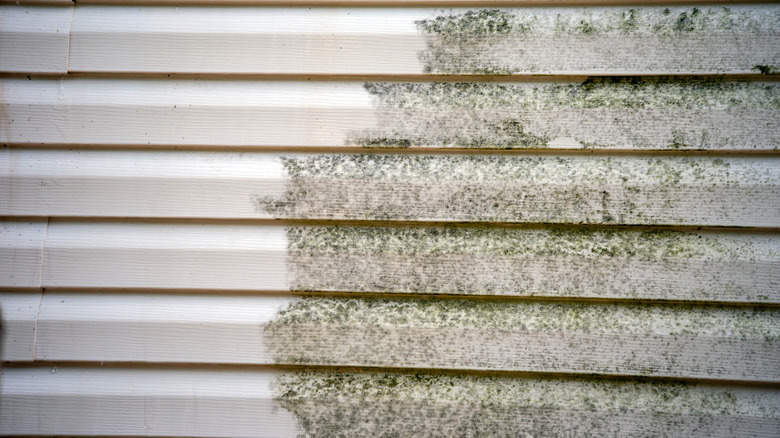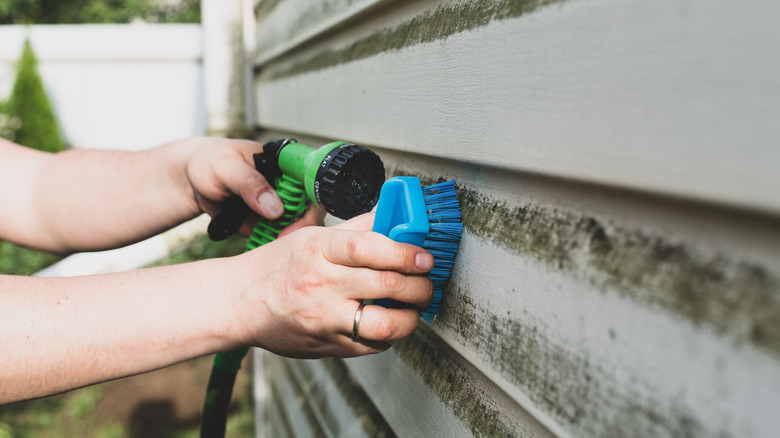The Gentle & Affordable Algae Removal Solution For Your House Siding
We may receive a commission on purchases made from links.
When warmer weather arrives, you may find yourself spending more time taking on outdoor projects. One important area to not overlook is your home's exterior siding. Do you notice staining on the material that's brown, black, or green in color? Such stains are one of the most prominent signs of algae or mold buildup. They're not only unsightly but can cause long-term damage to the siding if left uncleaned. Thankfully, you don't have to run out and invest in a pressure washer to remove this eyesore from your vinyl. All you need is a combination of dish soap and a soft bristle brush as an algae removal solution for your siding. It's gentle on the material and simple to execute.
Pressure washing exterior siding is a common cleaning method for algae removal, but it does not come without risks. It's great at breaking down tough stains but can cause damage to different types of exterior siding. Depending on the power washer's pressure settings and the integrity of the siding, this type of cleaning can lead to chips or cracks in the siding. Instead, get a bucket, a product like Dawn Dish Soap Ultra Dishwashing Liquid, and a soft brush with a long handle, like the type used to clean RVs or cars. This will be your best defense against algae buildup.
How to use dish soap to remove algae from siding
Once you've got your brush and dish soap, it's time to grab your garden hose and get to work. First, add a generous squeeze of soap into the bucket then fill with water. You'll want the soap to be diluted for this project, but there's no need for an exact ratio. Dip your brush into the bucket to combine the mixture. Next, use the hose to spray the siding, getting it nice and wet before moving on to the next steps.
Now comes the arm workout and actual algae-cleaning that will make siding look good as new again. Use the soapy brush to create friction and help loosen any stuck-on algae, especially in crevices and hard-to-reach areas. One helpful tip is to work with the grain of the siding texture for stubborn algae stains. Repeat the scrubbing process as necessary and rinse thoroughly once finished. You'll also want to make sure that you don't use spray the hose upwards at the siding, as there is a risk of the water getting underneath the material, causing serious issues like rotting. Making sure the water is running in a downward motion will prevent any long-term damage while cleaning (you may want to get up on a stepladder for the best angle).
Ways to prevent algae from building up on siding
Once you've put in the elbow grease of removing algae stains from your siding, you're going to want a long-term solution to prevent them from occurring again. However, many people are unsure how often they should be cleaning their exterior siding or may overlook cleaning it all together. A good rule of thumb is to clean siding every year or two, but you may have to create a more frequent cleaning schedule if you live in a humid climate. Still, regular cleaning with dish soap will prevent buildup from getting out of control and requiring excessive effort to remove.
Another simple algae prevention solution is to keep an eye out for issues that can lead to excess moisture building up on your siding. For example, keep gutters clear of obstructions that can lead to backups or rainwater pooling behind exterior housing materials. It's worth learning how to really clean gutters yourself to prevent such issues. It can also be helpful to keep an eye out for signs of excess moisture, like warping or new gaps appearing between each piece of siding.

